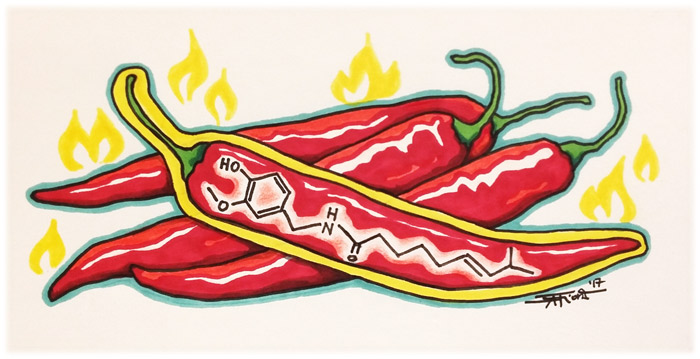Scorching heat, exasperated breathing, and trickles of sweat aren’t necessarily the result of a lengthy stay in a sauna or running on a hot day. They can instead result from a bite of spicy food. The chemical capsaicin causes the spicy sensation that some hate and others love. This compound is primarily found in the white membrane of peppers—not the seeds—and is responsible for a chili’s characteristically punchy flavour.
While the domestication and consumption of chilies traces back 6,000 years to the Caribbean, recent discoveries have been able to transform this pain-inducing compound into a pain-reliever.
To understand the healing properties of this strange fruit, it’s essential to know how and why it evolved its ‘heat.’ The spiciness of the outer flesh provides a defence against predators and fungi, which would otherwise prevent chili growth and reproduction, while the non-spicy taste of its seeds allow birds to feast on and disperse them, unharmed.
Humans have also taken a liking to the fruit—with 463 million pounds of hot peppers grown per year in the United States alone. North Americans’ appetite for spice has skyrocketed in the past two decades, with the consumption of chilies doubling and hot sauce dethroning ketchup as the top-selling condiment of 2016.
The chili craze can be attributed to capsaicin, which literally causes pain in the mouths of millions.
Capsaicin creates a burning sensation by activating the body’s pain receptors, or nociceptors. The nociceptors send a signal to the brain and cue the experience of pain in response to a variety of different stimuli, such as extreme cold, heat, or pressure. Each one of these intense sensory activators prompts the same neuron to send pain signals to the brain. Although they stimulate the same neuron, each sensation activates a different specialized pathway on the neuron.
Discovered in the last 20 years, TRPV1 is the receptor specifically set off by high levels of heat. While it is mainly activated by temperatures above 40°C, capsaicin also activates TRPV1.
The activation of TRPV1 by capsaicin, while also providing the gift of spice, serves a medicinal use.
There are many receptors similar to TRPV1 on nociceptors. Any one of these specialized pathways can cause the feeling of pain, and blocking one pathway still allows for many other mechanisms to activate a neuron signal. Initially, researchers attempted to block or “antagonize” the TRPV1 receptor from firing in order to reduce inflammation and pain sensitivity, but they recently discovered an even more effective treatment.
Instead of blocking TRPV1, scientists continually activate TRPV1 by applying low amounts of capsaicin to the skin for a long period of time. As a result, the nociceptor becomes temporarily deactivated, which eliminates all kinds of pain. Reza Sharif-Naeini, an assistant professor in the Department of Physiology at McGill, explained how this seemingly paradoxical technique works.
“The first time you apply it, it will be painful […] but eventually, the nociceptors [become desensitized],” Sharif-Naeini said. “[So] now, even if they get excited, nothing will be released.”
Therefore, no feeling of pain can penetrate the targeted area.
Sharif-Naeini went on to explain that the full desensitization process can take up to a week, but that it can be very effective for people with arthritis or psoriasis. In regards to the duration of the treatment, Sharif-Naeini said that a capsaicin patch allows for eight to 12 weeks of pain relief.
Capsaicin patches and topical ointments are now available both over-the-counter and by prescription, providing a location-specific and affordable treatment.
The humble chili’s key ingredient has once again transcended its origins as an irritating pest repellant. While this compound’s initial discovery brought pungent flavour into the masochistic mouths of adventurous eaters, recent applications are repurposing it from inducing pain to relieving it. Peppers’ capacities for pain and pleasure—like Yin and Yang—seem to be opposites, but are, in fact, inseparable.









